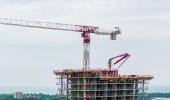'Marginal rates will definitely affect the consumer's decision in entering a new transaction, but in reality, they don't affect much because banks/financial institutions have come up with step-up EMIs: 50% of home loans which exceed 15 years in India are prepaid, within 7-8 years.'
'This doesn't happen anywhere in the world.'

Despite global headwinds, rate hikes, depreciation in the rupee, and other recessionary activities, the real estate sector will sustain its growth momentum in this festival season, Niranjan Hiranandani, co-founder and managing director of Hiranandani Group, tells Pratigya Yadav/Business Standard.
Economists have predicted a global recession. Will it impact the real estate market in India?
The Russia-Ukraine war and other recessionary trends in Europe and the US have definitely had an impact on India.
We are affected, but not to the extent that we have to be worried.
Despite such recessionary activities, we are still talking about 7 per cent growth.
Though we targeted double-digit growth despite the recession, we are still at 7 per cent.
The government's schemes and policies have also helped the real estate market to maintain balance.
Recently the RBI hiked the repo rate, by 50 bps, for the fourth consecutive time in six months. Industry experts have diverse opinions about its impact on the housing sector. What is your analysis?
The marginal rates will definitely affect the consumer's decision in terms of entering into a new transaction, but in reality, they don't affect much because banks/financial institutions have come up with step-up EMIs: 50 per cent of the home loans which exceed 15 years in India are prepaid, within 7-8 years.
This doesn't happen anywhere in the world. When the rates of interest again will fall, the EMI will come down.
How do you see real estate's growth before and after the pandemic?
The initial part of the pandemic was a setback for us, but later, the sector's growth went up, and the second quarter of the pandemic actually saw a rush by people to upgrade their houses or buy bigger houses.
According to industry reports, larger-size flats have suddenly got huge demand after the pandemic.

By what percentage has the housing sector demand gone up in the past year?
According to industry reports, demand in the real estate sector has gone up by 15-20 per cent in the past year. Demand has crossed the pre-Covid levels, too.
How developers are picking up initiatives for environmental, social, and corporate governance (ESG) compliance?
I think, overall, green tribunals, government, and courts are mandating the steps for ESG compliance.
Even companies, corporates, banks, and financial institutions are conscious of this fact.
Developers are already opting for green certifications for both residential and commercial projects.
Hiranandani also has platinum-rated green buildings for both segments.
We have been running sewage treatment plants of more than 4 billion litres in each of our two projects in Powai and Thane for 25 years now.
How are developers going to manage the challenge of retrofitting old buildings?
We are a poor country, and we are first looking at people to get houses.
For example, 50 per cent of the people in Mumbai are still living in slum areas.
The new upcoming buildings will be more green certified than the ones already existing.
We cannot take care of everything from the past, but, at least, we can look at the future.
How many projects are currently being run by the Hiranandani group?
We have currently more than five township projects currently running in Powai, Thane, Navi Mumbai, Panvel, Chennai, and Khandala. We also have a clutter of individual buildings in places.
What are the expansion plans of the Hiranandani group?
We are constantly expanding. So, yes growth is there.
We have a compound annual growth rate of 10-15 per cent.
What are the price trends in the real estate sector for all the segments?
During the pandemic times, prices did not go up but they have gone up by almost 10-14 per cent on average now.
In the luxury segment, growth is higher, on average -- 10-15 per cent growth is there in the past year in terms of prices.
In the affordable housing segment, growth is less, a percentage point rise to about 5-7 per cent.
In fact, the cost of construction has gone higher. So, there is compression in terms of net realisability.
What are the specific segments in which the group has its presence?
We do all of the segments, ranging from residential, commercial, retail, IT sector, data centres, and hospitals to schools.
We do all of them, be it the affordable housing segment, middle-income, high-end, luxury, top-end luxury, villas, or plots.
The festival season is already on. Which segment has seen most demand?
The largest part of our portfolio is the residential sector, which is around 70 per cent of the real estate business we do.
Commercial and other segments are also growing very rapidly. So, may be 1 per cent can change.
Feature Presentation: Rajesh Alva/Rediff.com











